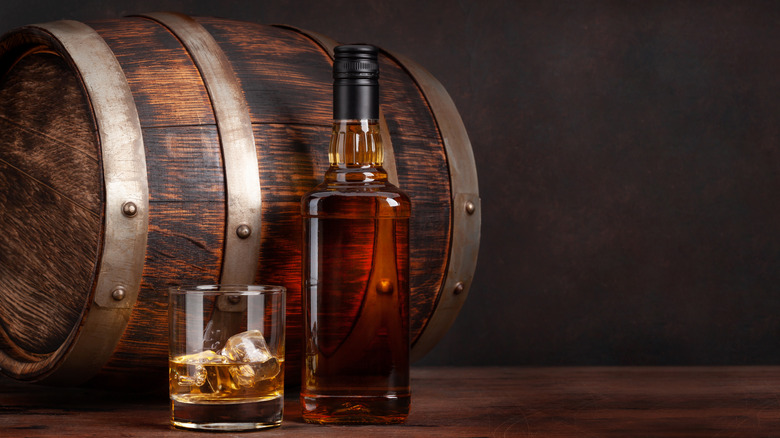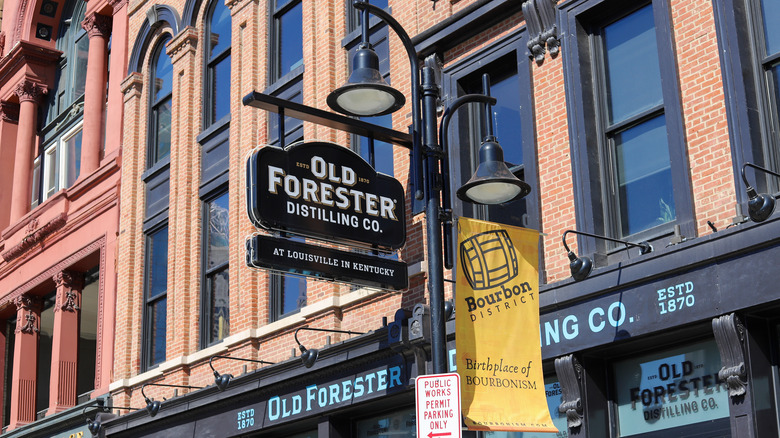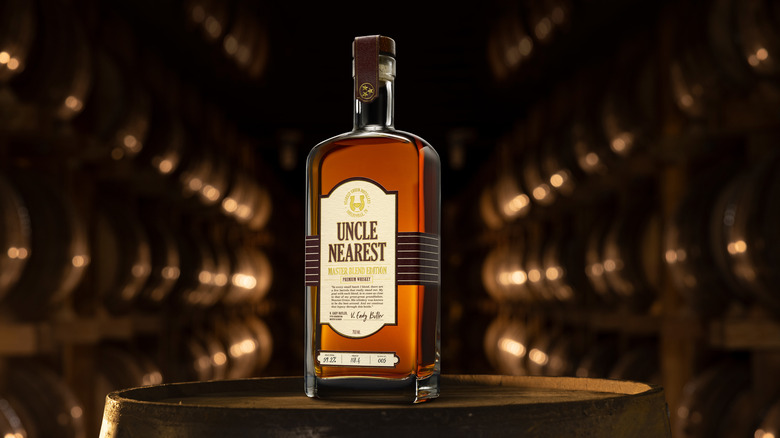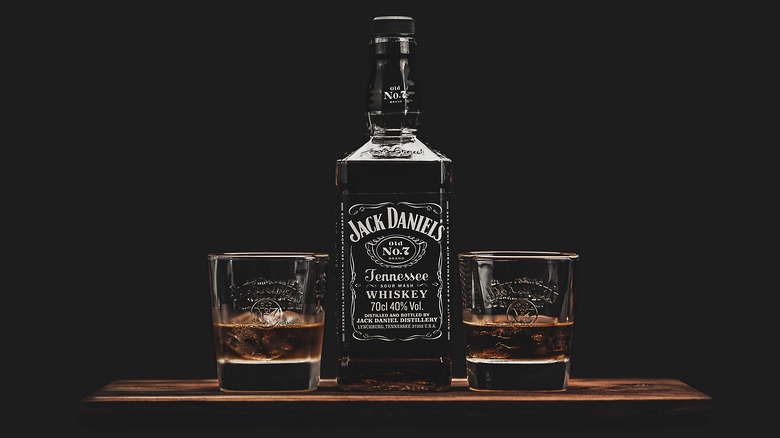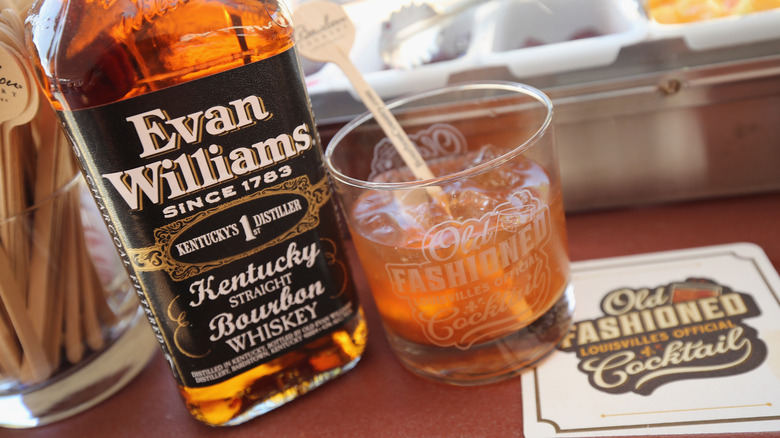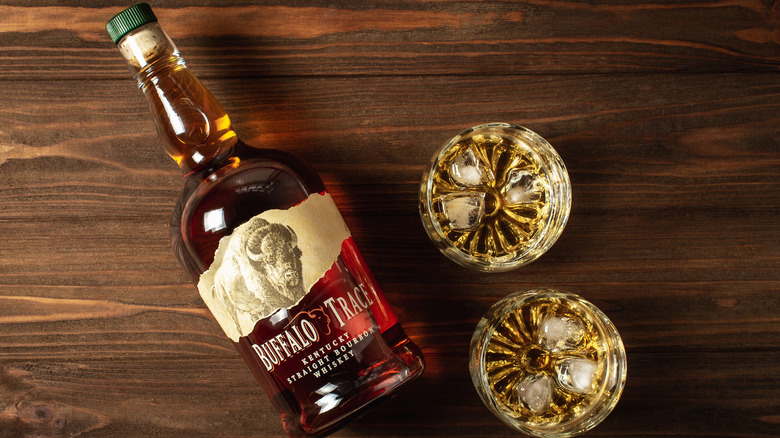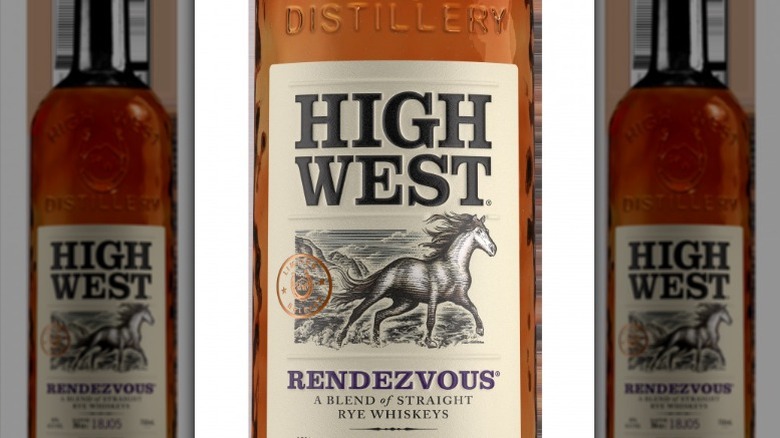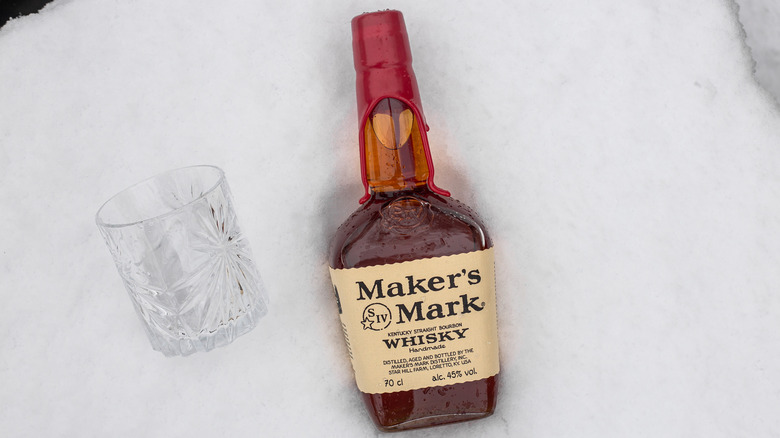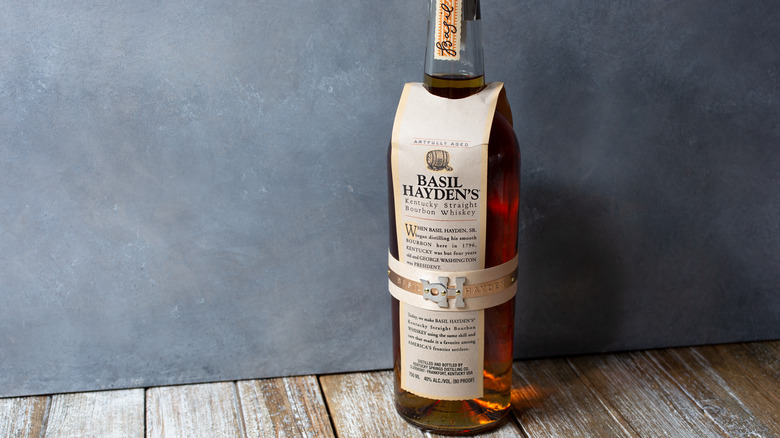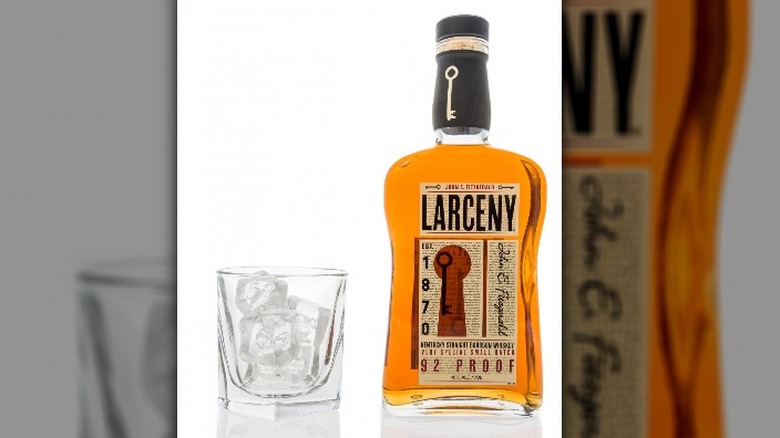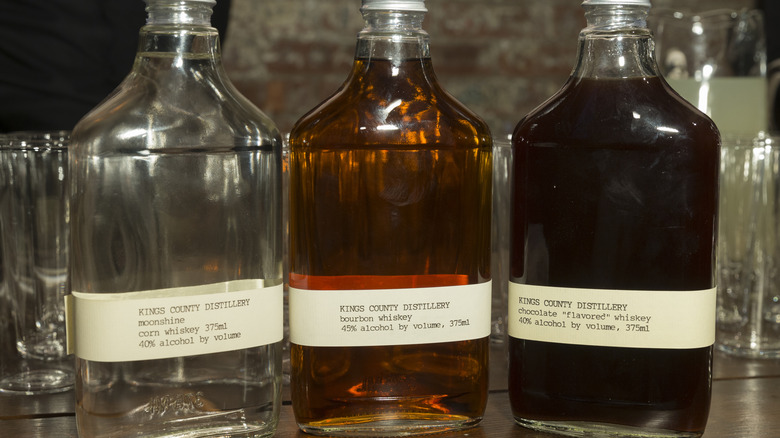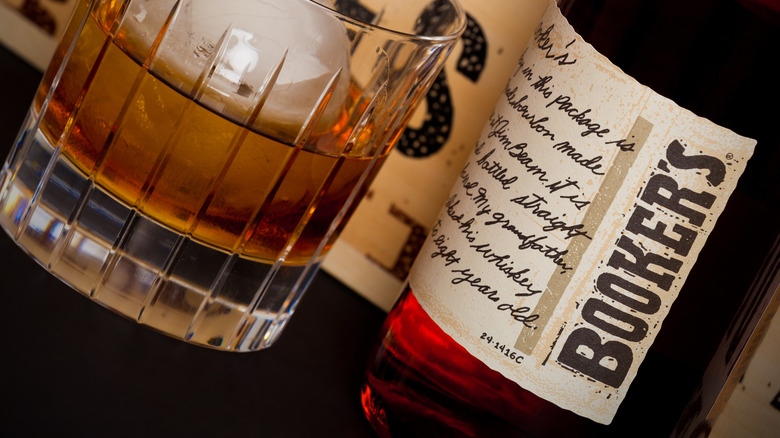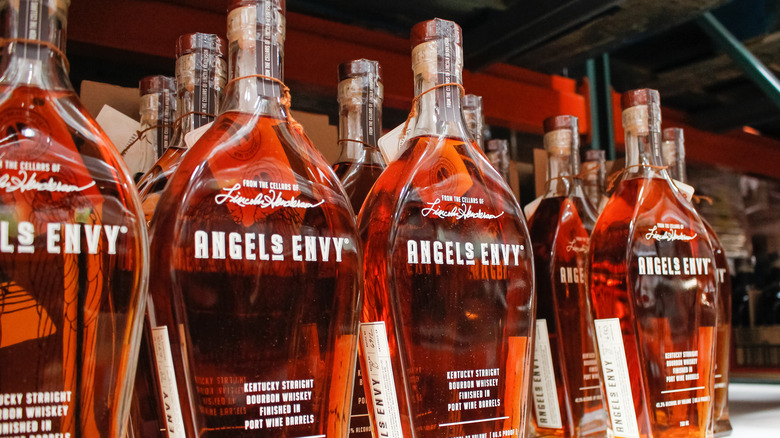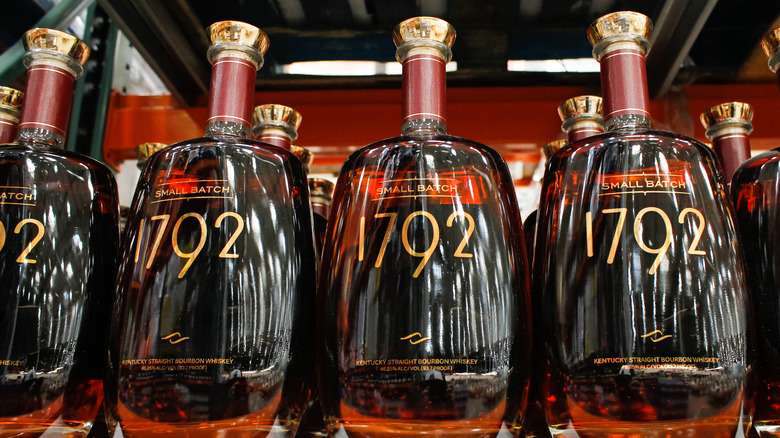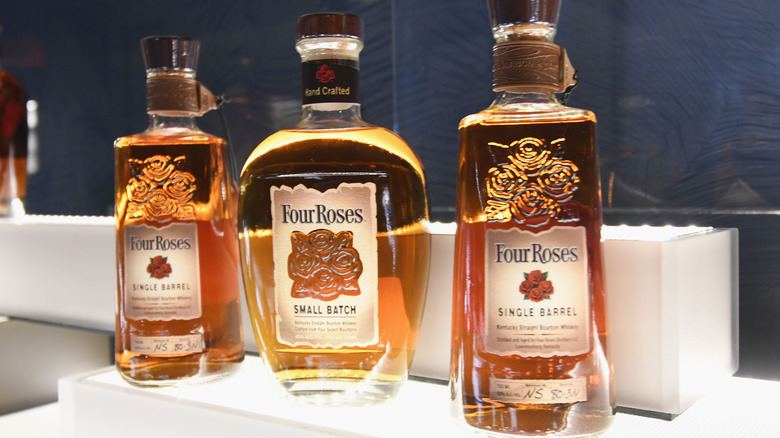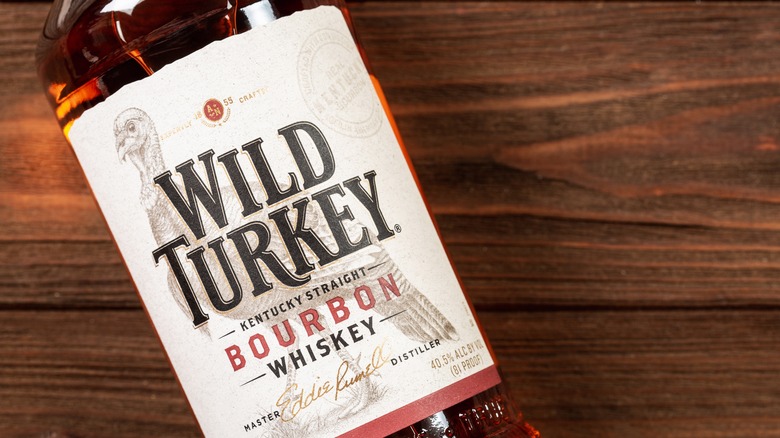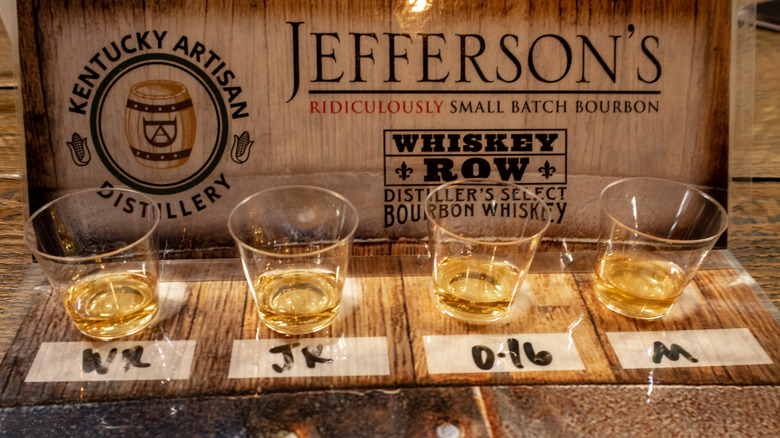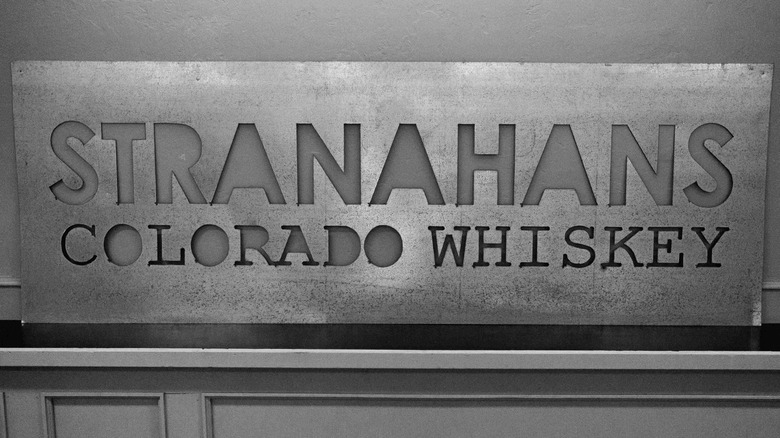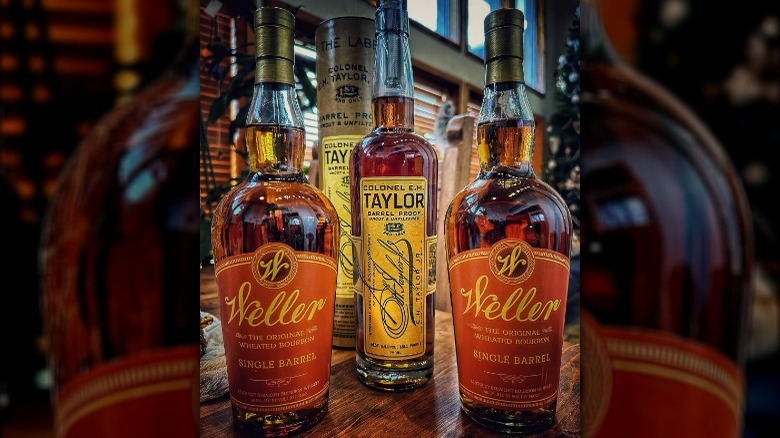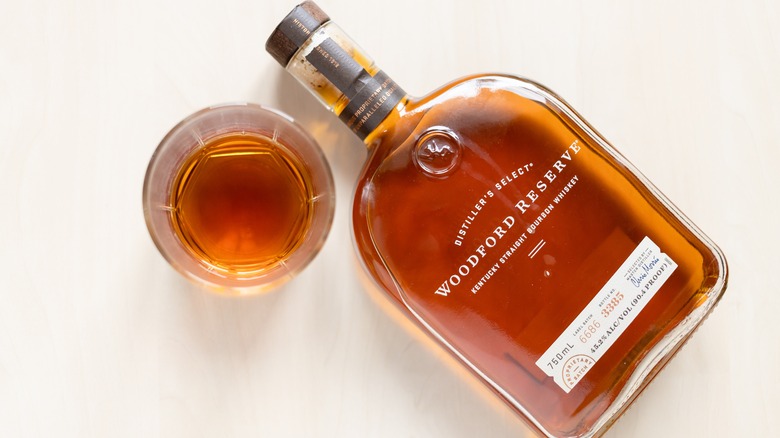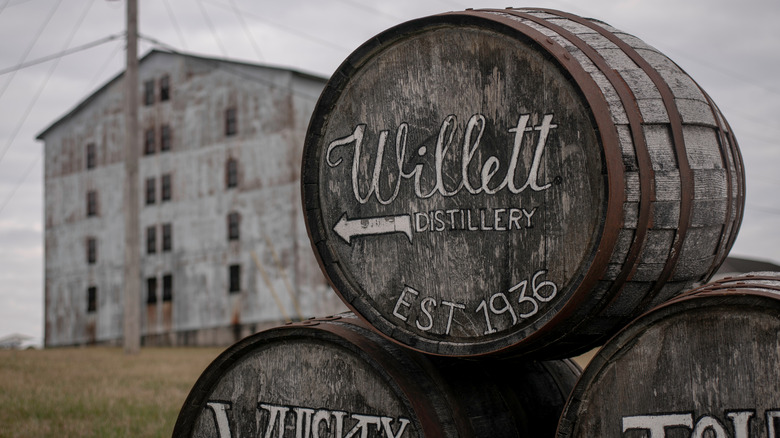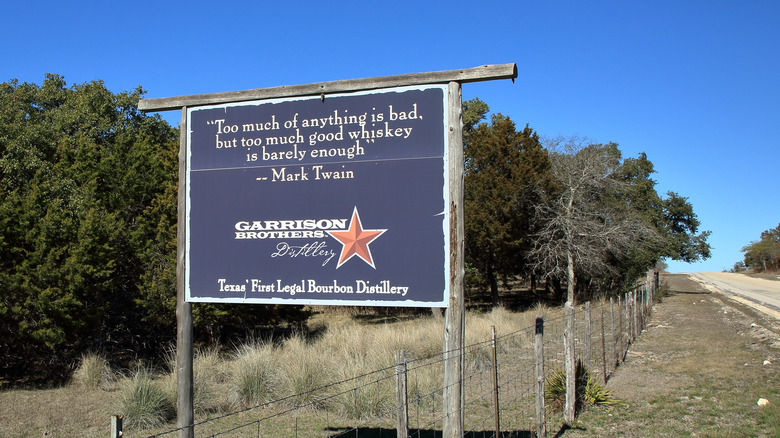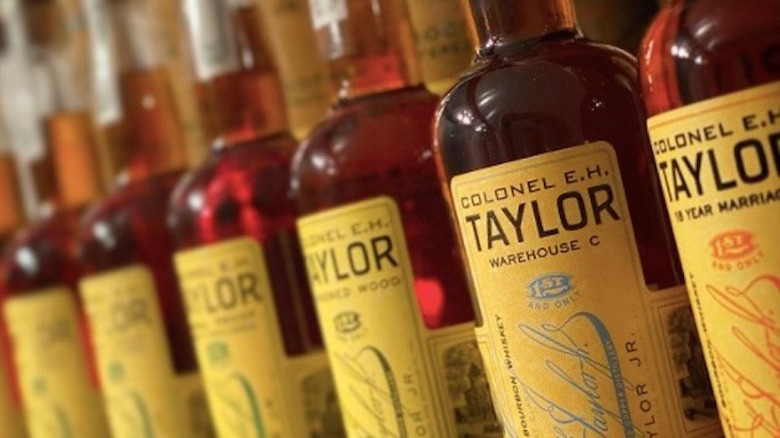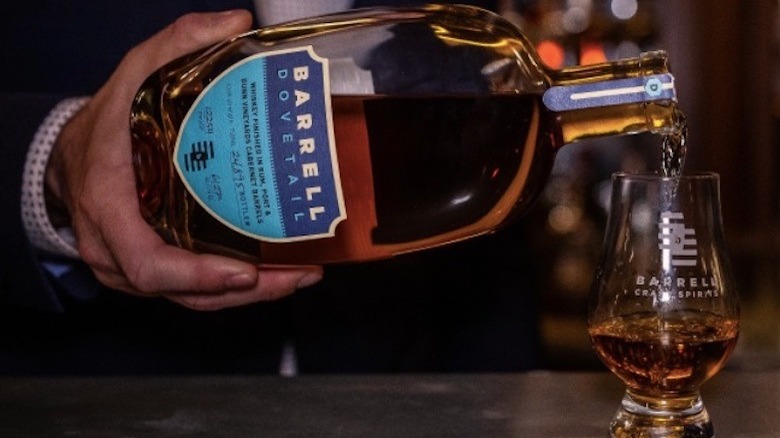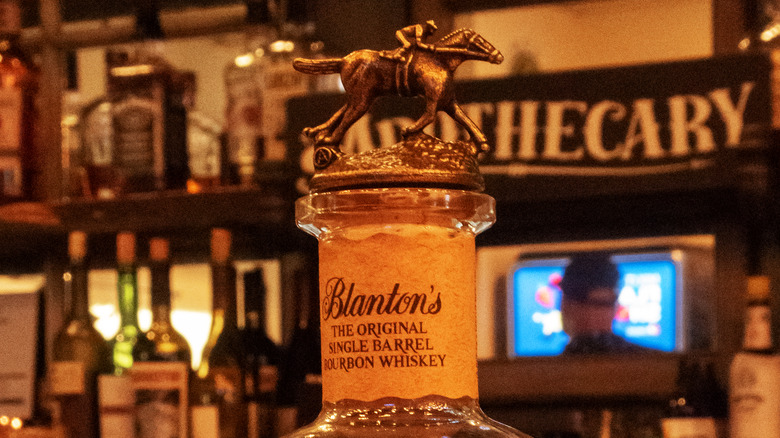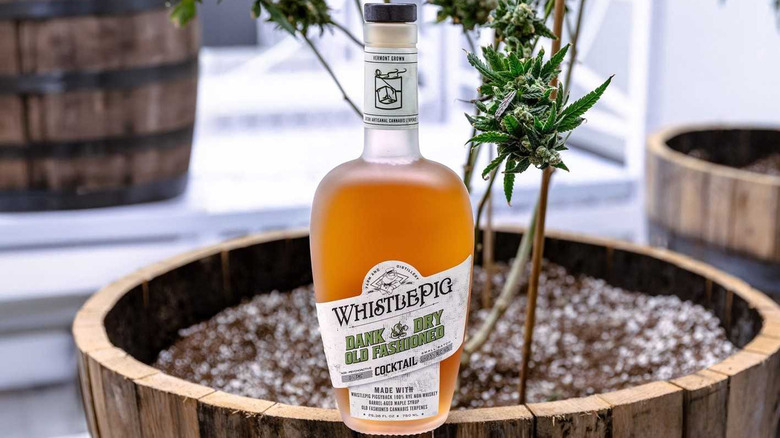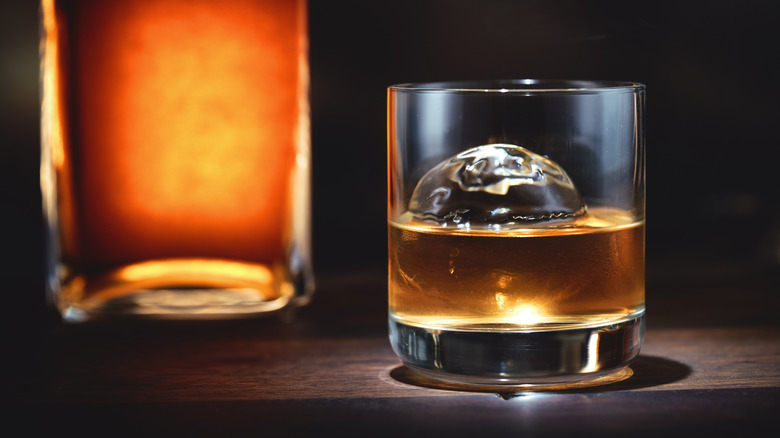25 Top American Whiskey Brands, According To An Enthusiast
America's whiskey tradition is a strong one. George Washington himself presided not just over the nation but the production of 12,000 gallons of whiskey a year, according to Mount Vernon's library. But what are the best American whiskeys? Who can say? Well, we can, and it's these ones.
Before we dive in, a few notes: First, we're ranking bourbon brands overall here, not individual labels or releases, so don't expect to see two different versions of Four Roses go head-to-head. That also means some of these whiskeys come from the same producers and many are made at the same distilleries. For that reason, the value is a factor as well — an underpriced B+ whiskey is a better deal than an overpriced A- option.
We also considered accessibility as a factor. Procuring a great bourbon with limited distribution can be as much of an expenditure in terms of time spent as the cost of buying a bottle of Pappy Van Winkle, so these are the whiskeys you're likely to find in large swaths of the United States. Next, we excluded anything flavored in order to let the whiskey stand alone. Though, if you need a recommendation, Howler Head's banana bourbon is astonishingly satisfying. And finally, don't agonize over which one to buy too much. If a drink is on this list, it's already certain to satisfy. With those disclaimers in place, let's take a shot at sorting out America's best bottles of whiskey.
1. Old Forester
As America's oldest continuously operating whiskey brand, Old Forester touts its 1870 established date on the logo. The brand uses the old "whisky" spelling and trademarked the tagline "First Bottled Bourbon" to distinguish its historical role; previously, bourbon was served from barrels. Old Forester also lays claim to the first double-barreled bourbon, devised out of necessity during a plant fire. Although, the effects were noticeable and pleasant enough to repeat the process.
That same timeline shows legacy counts: This is a brand that returned to its original distillery and recipes to maintain the continuity of the business. It even operated during Prohibition under special medical license. In 2008, the company released Repeal Bourbon with its 1930s recipe at 100 proof (via Louisiana Business Journal), the legal requirement of the time. Because again, this is a brand that returns to its history.
But, how does it sip? Well, you might find Old Forester, on paper, a bit like apple pie, though it's far from an Applejack on the tongue. Reviewers like Whiskey Rocks often also cite notes of banana, chocolate, and nuttiness. But, for actual chocolate, Old Forester sells bourbon-dipped modjeskas and truffles. Despite its high-rye mash bill, it's not too spicy or heated, and Whiskey Rocks calls Old Forester the bottle of choice for liquor cabinets looking to keep a single, all-purpose whiskey on hand.
2. Uncle Nearest
First and foremost, Uncle Nearest is a clear-tasting whiskey with a rich flavor that will resonate with fans of most Irish labels. Welcoming to the nascent drinker, the highly awarded bourbon plays as well with soft drinks as it does neat.
Now, as to the complex story of this Tennessee spirit: The New York Times reports Jack Daniel's only began restoring master distiller Nathan "Nearest" Green to his place in alcohol's history after 150 years of operation, including Green's role in the education of distillery owner Jack Daniel. While still enslaved, Green taught young Daniel but never received his due in the narrative. CBS News reports that Green was officially Jack Daniel's first master distiller, and numerous descendants of his have worked there.
When author Fawn Weaver read the Times article, she tracked down details in person, hoping to complete Green's story. Instead, she decided to honor him by founding the Nearest Green Distillery. Inc. magazine says Weaver broke barriers in founding and helming a major spirits company as CEO, while also assembling an all-female, all-minority executive board. And its master blender? Green's own great-great-granddaughter, Victoria Eady Butler. Weaver also finances the Nearest Green Foundation, a nonprofit devoted to his legacy, which provides scholarships to his descendants.
All that, and it's a fine sip of whiskey. Butler is already winning prestigious whiskey awards. Given a few more expressions, Nearest should have quite the library to match, and often, best the other labels in this list.
3. Jack Daniel's
Listen, if it's good enough to be Frank Sinatra's favorite drink, it's good enough for the likes of us. While whiskey has a few standards, it's probably only Jack that has attained such iconic status that its Old No. 7 black label is what people picture when they hear the word whiskey. Whisky Magazine says it really was Sinatra's favorite, along with many other musicians whether crooners, rockers, or somewhere in between (we see you, David Lee Roth). In fact, the magazine says Sinatra's influence led to generations of musicians to ask for a bottle of Jack as the standard in a dressing room, and while never hired for his endorsement, Old Blue Eyes gladly name-dropped the Tennessee whiskey for free. Now, he has his own posthumous Jack Daniel's select whiskey.
While Jack Daniel's may be the American whiskey for decades now, there's never been a better time to try a handle. Whether you've never sipped it or want to reconsider your opinion, since — as Inside Hook notes — their Bonded line may be their best whiskey ever, and priced to try. As they're bottled-in-bond, a distinction of quality control, it's a solid bet. Jack Daniel's Bonded is essentially the crème de la crème of the Old No. 7 standard, while the Jack Daniel's Triple Mash blends three other bottled-in-bond Jacks, primarily their rye.
4. Evan Williams
What? Yes, we said it. Evan Williams is the better buy for whiskey drinkers than Jack Daniel's. For too long, Evan Williams has labored in America's collective mind as the budget Jack Daniel's. But, in truth, Evan Williams is a darn fine pour for the price. The quality and flavors are comparable to Jack except they are smoother and, frankly, more satisfying, with the additional selling point of coming in at half the price.
If you're buying either of these whiskeys, you're often mixing them into Coke or Lynchburg lemonade (or, would that be Bardstown?). At any rate, Evan Williams's higher proof of 86 over Jack Daniel's 80 is a slight advantage. Barrel & Brew says the distilling traditions were set by Welsh immigrant Evan Williams in the 18th century, and now the brand Evan Williams has serious credentials to put up against the better-marketed Jack.
But, all that matters is the taste, right? As noted, Evan Williams is a fine standard but really shines with its bottled-in-bond white label and, surprisingly, the lighter-proof green label. Either makes a great mixer but will surprise as a pleasant enough shot to sip on. Sweet and homey in its flavor profile, Evan Williams is a cozy whiskey that always does what it offers and at a very satisfying price point.
5. Buffalo Trace
The Buffalo Trace Distillery is the cradle for many great whiskeys, but its flagship bottle, Buffalo Trace Kentucky Straight Bourbon Whiskey, is a strangely quiet achiever. Widely recognized by critics, but never quite celebrated among drinkers by word of mouth, Buffalo Trace may be an undeserving victim of its own precision. The quality is present, but the brand occupies a center space where it demonstrates the truest qualities of Kentucky straight bourbon yet lacks a recognizable identity because of it.
Breaking Bourbon reports the master distiller Elmer T. Lee curated the most exemplary, older whiskeys for its small-batch blend and concludes the lack of uniqueness is not a bug, but a feature. Its signature whiskey is meant to showcase quality foremost, which rises well above its fairly low sticker price. Liquor.com calls Buffalo Trace bourbon a benchmark while flattering its minimum eight years (and counting) aging process.
All in all, Buffalo Trace is a studious workhorse on a shelf full of flashy rockstars. Drinkhacker calls Buffalo Trace bourbon beloved, but an obvious oversight for many drinkers, before praising its butterscotch flavor then dinging it for tasting about half as aged as it might. Bourbon Inspector agrees but ultimately concludes that while the short finish might be unremarkable, few comparatively priced bourbons can stand up to it. And, Whiskey Bon's reviewer was pleasantly impressed by the quality to cost after expecting a ho-hum staple. You're getting $50 worth of meditative sipping in what will cost around $30 per bottle.
6. High West
If we apply the "Breaking Bad" principle that a chemistry degree equals a better product to whiskey, then High West cofounder David Perkins' former career as a biochemist is good news for this brand, which is the first legal distillery in Utah since 1870. The extremely rye-centric High West line has a bottle for every palate.
Whiskey Rocks says High West blends whiskeys from its at-home distillate with various sources but primarily from the powerhouse Midwest Grain Products of Indiana, which produces for a great number of whiskeys. The site also praises High West's standard offering as a well-placed middle ground to offer something to everyone. The Whiskey Jug pinpoints the somehow-still-remarkable maltiness of the single malt. And while we'd love to advocate the Campfire for leaning into a cloud of smoke, it's blended with scotch and technically excluded from this list of recommendations (but that doesn't mean you shouldn't get your hands on a bottle if you can).
While all the whiskeys on this list are great, and many are underrated, High West feels like a particularly egregious oversight in the whiskey discussion, as reviews return to its versatility in almost any situation, combination, or drinking preference, without ever being weak and vanishing into its liquid cohorts. Don't fall for mock outrage like The Daily Beast's at the scandal of whiskey makers contracting factories for their production capabilities. High West is proof of concept.
7. Maker's Mark
Yes, this deliberately mellow American brand labels itself "whisky" rather than whiskey. While Maker's Mark is a mid-20th century concoction registered long after Irish and Scottish spellings contentiously diverged, the brand says on Twitter that "whisky" was a deliberate nod to founder Bill Samuels Sr.'s family roots. Granted, the elder Samuels was a sixth-generation distiller using his family's 170-year-old recipe, so Maker's Mark didn't spring from nowhere.
While it has acquired new owners, Maker's Mark remains under production by three generations of Samuelses, including the founder's rocket scientist son Bill Jr., who's on history's short list of people who have worked with both real and metaphorical rocket fuel. Few distillers can draw on such a direct line of knowledge and experience, and it shows in the brand's tasting profile.
The quality is a given, but Maker's Mark is also unobtrusive, a hallmark of wheated bourbons — known for soft, almost buttery, smoothness — a style that is enjoying its hour at last. The first of the premium bourbons, and a mainstay of bars everywhere, the famous wax-dipped bottle is a real standard for both bourbon and American whiskey.
While the original is a ubiquitous litmus test — if you don't like it, you probably just don't like bourbon — Maker's 46 is a simplified version, aged in cooler temperatures, which mixes beautifully in Manhattan cocktails. Bill Jr. spent so much effort refining this highly affordable bottle that he called it more difficult than rocket science. He would know.
8. Basil Hayden's
Very few people get their own whiskey label. How many besides Basil Hayden get two? In addition to the bottle that bears the Basil Hayden name, the originator of Old Grand-Dad named the label after the term of endearment for his grandfather. The two whiskeys even use the same mashbill.
Flavor-wise, Basil Hayden's is light enough to enjoy without a major kick, especially for a high-rye whiskey, and bears interesting notes like pepper, berry, and leather. Yet, you won't feel bad about submerging those finer details into a cocktail and letting other liquids take center stage while this blend just provides the alcohol. If you're looking for a whiskey to spike your summer drink, this is your mixer right here.
It's yet another entry from the Beam Suntory family and in close company with its much more robust cousins, Booker's and Baker's. This, Basil Hayden's website says, was deliberate on the part of the eponymous distiller Booker Noe, finding inspiration from the 18th-century rye farmer Meredith Basil Hayden Sr. The lower ABV renders this whiskey accessible to more delicate palates without shortchanging those who like their whiskey to announce itself. It's smooth by design and smooth is always welcome at the party.
9. Larceny
Any label that rubs elbows with Pappy Van Winkle has become a sought-after commodity. And, while Old Fitzgerald Bottled-In-Bond hasn't been a product of the Pappy family on this side of the millennium, 20 years isn't much time in the lifespan of this small-batch whiskey. Barring decanter releases, Old Fitzgerald is only shipped twice a year, in spring and fall, and you're not likely to find this bottled-in-bond bourbon at every liquor store.
The good news is that within the family you can easily get your hands on a bottle of Larceny bourbon. Where Old Fitzgerald is named after the U.S. Treasury agent who purportedly stole countless volumes of whiskey while inspecting for bond quality, Larceny derives its name from his purported crimes. That means you're getting a very similar item, minus the premium guarantee of the bond standards.
Larceny is finally receiving some of its due attention as wheated bourbons continue to rise on the tide caused by Pappy Van Winkle's brilliant arrival to collector status. Spirits Review says this wheated bourbon imparts a bread-like flavor to its thick and oily (in a good way) heartiness. The Whiskey Shelf agrees with the breadiness while finding strong citrus and floral elements, which it credits to the yeast strains used at the Heaven Hill distillery.
10. Kings County Distillery
Yes, Kings County Distillery really is produced in Brooklyn, New York. While the Williamsburg neighborhood, circa 2010, may conjure up images of curly mustachios figuring out their roles in life, east Williamsburg remained an industrial district. A distiller might have carved out a bit of low-cost rent to create some truly amazing whiskeys. And, the folks at Kings County did. Though, they've since relocated to the Brooklyn Navy Yard with pot stills and open-air fermentation, this upstart retains plenty of cred.
There is no shortage of options to enjoy with Kings County, including several unaged, flavored whiskeys that garnered praise from deliberately skeptical sources like The Whiskey Wash. But, since we're focused on traditional whiskey, turn your eyes, nose, and tongue towards the tempting bottles of bourbon. In a rarity for bourbons, the brand released a peated malt version that 31 Whiskey praises for its groundbreaking results in which the peat strikes first before the sweetness of the corn.
It seems like Kings County has made its way by hitting all the classics of bourbon from the past 40 years, yet, putting a signature touch onto each. Its barrel-strength release has a remarkable thickness, according to Breaking Bourbon, which recommends the younger-statement Kings County Barrel Strength Bourbon over the brand's bottled-in-bond expression. In all cases, Kings County surprises. In few, if any, does it disappoint.
11. Booker's
Now, this is not a bourbon for amateurs. Booker's is part of the Jim Beam family of small-batch bourbons that includes Baker's, Knob Creek, and Basil Hayden's. Booker's is the company's bucking bronco: bottled uncut and unfiltered at cask strength and subject to fluctuations in each batch, so you can never really know what you're going to get. Out of the many delineations and synonyms in whiskey terminology, Bourbon Inspector urges you to try barrel-strength bourbon as the top of the top.
It's a bit ironic that something that comes out so closely resembling what went in, enjoys such variance between batches, but Booker's batches do lean toward an entangled sweetness and heat, whatever the iteration. Bottles are hand labeled to mark their pedigree, including percentage breakdowns and their aging location, so that connoisseurs can compare trends among the different batches. While such nuance as which floor of a certain warehouse yielded a batch might sound hyper-focused, that's exactly how the furious enthusiasm for Pappy Van Winkle created runs on other labels.
So, Booker's won't be for everyone. But, even those who don't find it to their tastes will have to respect its potency and bold flavor as a declarative whiskey.
12. Angel's Envy
Master distiller (and Kentucky Bourbon Hall of Fame inductee) Lincoln Henderson came back from retirement to test an idea with his son Wes. They borrowed a trick from scotch and finished their bourbon in port wine casks — the result was Angel's Envy. While the elder Henderson passed away in 2013, his grandsons have joined the craft, ensuring the innovation and standards important to him continue development.
That final step does make this brand contentious. The Whiskey Jug argues that finishing this specialty whiskey in a barrel other than new, charred oak (per legal standards for bourbon) pushes it past the parameters to continue being called bourbon. Others view the Alcohol and Tobacco Tax & Trade Bureau's standard for bourbon as a minimum to be met, not an exclusive requirement that can't be surpassed.
The government would seem to agree, as the label says: Kentucky straight bourbon whiskey finished in port barrels. The final answer may even lie in how long the whiskey lies in oak to qualify as straight bourbon before moving on to port, or, in later projects, casks that formerly housed rum and sherry. Angel's Envy bourbon whiskey resides in oak for about four to six years per batch.
Regardless, that's not the end of the divide for this whiskey. The residual wine underpins the honey and oak with stand-out echoes of raisins, nuts, and biscuits. Some may find its particular sweetness too cloying, but for those who love it, distinction equals attraction.
13. 1792
Don't let the name fool you: This bourbon brand only just entered its second decade of production. Rather, 1792 refers to the year Kentucky became a state. Although, 1792 does remind us that the bourbon is distilled at a historical 19th-century Bardstown Distillery.
Unlike a lot of new-ish bourbons, 1792 brandishes its rye spiciness proudly. The Whiskey Shelf says it's essential to let a pour of 1792 Full Proof sit for half an hour to blow off the strength of its 125 proof, which is the same level it entered the barrel. Once it's ready to drink, the fruitiness and heady aromatic components are at their most enjoyable power, with anethol traces prevalent in the rye. It's a rollercoaster of heat and sweetness, which you might recognize in your own life as how falling in love feels.
More impatient drinkers might prefer 1792 Sweet Wheat (because who doesn't enjoy a wheated bourbon?), which stands apart as having notes of banana and tobacco along with the usual suspects of vanilla, caramel, etc. It's another whiskey that can fluidly move from standalone savoring to an excellent mixer, even as an elevated old-fashioned cocktail.
At a very decent price point, 1792 bourbon is hard to beat for satisfaction in all its forms. It could easily be the only bottle on your shelf if you're not looking to create a large whiskey library.
14. Four Roses
Four Roses is a bourbon brand that can be whatever you want to make of it. It's an affordable, reliable, off-the-shelf bourbon that any aficionado will tell you they consider a good value for the price. The whiskey cognoscenti (not to be confused with the cognac-scenti) love its small-batch and single-barrel options, but you don't have to invest very much money to enjoy expertise in its standard form.
Furthermore, Four Roses may still be burdened by when the brand was, as The Atlantic put it, sending the good stuff abroad and pumping out a disappointing blend at home — a poor showing for what had once been America's bestselling bourbon. Thankfully, new owner, Kirin Brewery, has been restoring its reputation at home as a straight bourbon worth chasing. And what a reputation it has become. The Atlantic called its 2008 Mariage the best bourbon out there.
This brand is the smart choice for anyone looking to try premium whiskey, as well as a quality buy for people who want the standard bottle handy at home for its versatility. You can enjoy Four Roses neat, on the rocks, or mixed, without ever feeling like it's an opportunity cost.
15. Wild Turkey
Wild Turkey may be broadly regarded as a low-price spirit, but that's a limited view and a casualty of just how long and how well the Russell family has been perfecting their craft. Master distiller Jimmy Russell could wring artful whiskey out of the unpopped kernels at the bottom of a bowl, while his son Eddie Russell has learned two lifetimes of experience growing up under his father's wing and is rightfully regarded as a living legend alongside his dad.
Ask any bourbon expert, and they'll speak of the father-and-son team with deep reverence for their consistency and commitment to bourbon's legacy. Thrillist cites Wild Turkey's superior process for its Russell Reserve, whereas many other distillers alter a product's flavor for ABV efficiency by aging high and watering it down after it comes out.
As reliable as the starter offering is, when you begin to peruse Wild Turkey's premium offerings, it very quickly becomes an attractive proposition. The quality-to-price ratio may be unbeatable in the American whiskey market and offers many of the same attractors in both taste and cost that Four Roses enjoys.
16. Jefferson's
While Dance Music Northwest reports that many brands are using high-bass music to agitate whiskey and promote interaction with the barrel's wood, Jefferson's found an even more intriguing and passive method to age its product faster with briny results. Many of the Louisville-based brand's whiskeys get hauled around the world's oceans, where the rollicking tides and temperatures do truly interesting work on their profile. Darker, richer, and teeming with the countless caramelization compounds formed by hyper-aging, Jefferson's aged-at-sea whiskeys are truly an experience for the exploratory whiskey enthusiast.
There was a time when you couldn't find anything else like Jefferson's, although a particularly salty Islay or the Highland's marsh scotches might have gotten you close. But, its results were so fascinating that VinePair reports other brands are now undertaking the effort to replicate the effects of the sea on aging whiskey. The endless sloshing of the waves, in conjunction with the heat of the metal containers, keeping the barrels in place, catalyzes the aging process. Founder Trey Zoeller told VinePair she particularly cites Voyage 13's ordeal in three separate hurricanes as creating a wildly sought-after whiskey like none other.
Better still, Jefferson's and OCEARCH paired up for conservationist and data-gathering oceanography programming to preserve marine life as the ship hosts barrels of delicious, distilling whiskey. You can track most of the Jefferson's batch's voyages on the company's website.
17. Stranahan's
This is such an excellent small-batch whiskey, you'd think it had been in production for 150 years. But, the first bottles didn't roll off the line until 2008 after just two years of aging, according to 31 Whiskey. That aging was done in new charred oak barrels, one of the qualifiers for bourbon. Yet, Stranahan's isn't bourbon, as it lacks any corn, let alone the 51% of its mashbill required to use the term (via Of Whiskey & Words).
In fact, Stranahan's original version's entire mash bill is malted barley, borrowing from yet another type of whiskey: single-malt scotch. It's America's first such label. Combining the best of both worlds is a shrewd move, says Bourbon Culture, as the charred oak accelerates the aging process, thus the two-year sprint.
Further defining its outsider cool status, it's a Colorado whiskey — the first one distilled in the state since Prohibition. Whether it's different yeast strains or its exceptional process, Breaking Bourbon is just one of many reviewers to detect notes evident nowhere else, including creamed corn (better than it sounds, trust us). Whiskey Rising finds a bran muffin on the nose and kiwi in the sipping but credits the immense cornucopia swirling around this pour as fodder for almost any element you'd care to detect. It's also the very rare whiskey to get recommended as a digestif, even though sweeter options exist.
18. W.L. Weller
If you wait too long to find a bottle, the Weller lineup might vanish from this list for becoming impossible to either find or afford. The entry-level W.L. Weller Special Reserve varies from $50 at liquor stores, when not chasing rising prices, to an increasingly common $90. More premium expressions will run you a few hundred and even four figures. Breaking Bourbon laments the days (just a couple of years ago) when you'd pick up this crowd-pleaser for around $20-25 and cautions new drinkers against overpaying on what's become a find for collectors and come-lately connoisseurs.
For all that hullabaloo, this is a spectacular wheated bourbon. Get your gloves on the green label Weller Special Reserve, and you'll suffer no remorse sipping one of the most satisfyingly smooth-wheated bourbons ever made. Weller Special Reserve touts whispers of honeysuckle, something few whiskeys can boast. The Whiskey Shelf finds the special reserve's floral notes more of the citric variety, in a very favorable reminiscence of Van Winkle Lot B and 12 Year bottles, but agrees this bottle is rapidly becoming overpriced.
Even if the garden-variety W.L. Weller is a casualty of its own success, the brand's higher-end offerings only improve on what's already a great bourbon. Experts may bemoan that the label is outgrowing its britches, but it's hard to criticize a great bourbon shaking off its undervalued advantage.
19. Woodford Reserve
It's hard to imagine a greater recommendation than to be embraced as the official bourbon of the Kentucky Derby. But for more than two decades — almost from its start — Woodford has held that sponsorship, Vine Pair says. Yet for all its select status, well-regarded product, and elegant branding, Woodford Reserve's bourbon remains moderately priced. While the high-corn mashbill definitely tailors this whiskey to mint juleps (on Derby Day or otherwise), it contains enough rye to kick like a horse in all the right ways.
Woodford Reserve's original master distiller was Lincoln Henderson, who also created Angel's Envy, before turning over the reins to their current holder, Chris Morris, who's been at this bourbon game for over 45 years. Morris, in turn, has an assistant master distiller, Elizabeth McCall, one of the youngest female distillers in the world. The Woodford line spans a lot of history in just a couple short strides and will likely continue to do so.
Like many of the brands here, there are releases that explore in any direction you'd care to go if you want to emphasize particular aspects of the Woodford base: wheated, rye, double-barreled, malt, and Baccarat, which is finished in XO Cognac barrels, similar to Angel's Envy. Looks like Henderson's influence remains lively at the brand.
20. Willett
It's hard to call Willett a brand. In the sense, Willett Distillery is employed throughout this list through the family behind Kentucky Bourbon. But, it's equally hard to separate any of its offerings from each other when they're all fairly independent labels from Willett Distillery. Sure, there are a few iterations of Old Bardstown and Johnny Drum, and you've likely encountered Rowan's Creek or Noah's Mill at the bar. But, it's the Willett name that unites all of them, and the Willet label releases are the best regarded.
Vine Pair invokes the wild fanaticism of this brand, saying it has had an absolute banger of a 21st century under scion Drew Kulsveen. The Willett renaissance has only grown with the 2012 completion of distillery restorations and renovations, putting out about 5,000 barrels a year. And enthusiasts and critics alike have taken notice.
So, it's a great product at an undervalued price. Willit is crackling with attention from people who know what's up, and it is currently on the ascent of its own comeback story. If all that doesn't make Willett one of the top bourbon brands to watch, you probably didn't enjoy "Rocky," either.
21. Garrison Brothers
A bottle of Garrison Brothers is easy to locate, but hard to find, as knowledgeable whiskey whistlers have spread murmurs of the brand's greatness to all who will listen. For now, we're safe from Joe Public casually strolling up and ordering this brand to impress whoever's looking, but the word is out among enthusiasts.
And it's not just high talk, either. This Texas sun-scorched bourbon is notably superior from the first sip with its oak-forward, spicy, fruit-salad flavors that are so rich you'll swirl this one around the tongue quite a few times before saying a sorrowful goodbye to each swallow. In an interview with The Whiskey Wash, Dan Garrison credits the limestone in Texas, along with some lucky receipt of the "wrong" batch of corn that kicked out an impressively high sugar yield for amped-up alcohol production that also tastes great.
How often can you say a bottle that hovers around a hundred bucks is worth every penny? Some of its more innovative outliers like Laguna Madre will run you well into the hundreds, if not higher, but you don't need to sample the prize trophies to appreciate how exceptional Garrison Brothers truly is. Just pick up the Small Batch as a starting point, and see if it isn't the best thing you've ever put in your mouth that wasn't deep-fried. You'll find it isn't long before you're scouring for a deal on their Cowboy Bourbon as a birthday gift to yourself.
22. E.H. Taylor, Jr.
In a right-ordered world, this would be our top pick, but we have to acknowledge the realities of the larger landscape. Regardless, you may quickly find Colonel E.H. Taylor Jr.'s bottle of sunshine and smoke to be your own personal favorite as well, owing to the fact that the good colonel was a titan in the early days of large-scale commercial whiskey. He refined the process of bourbon creation with numerous inventions and improvements that are still applicable in the modern day.
E.H. Taylor's pristine taste is expressed in a squadron of desirable adjectives one doesn't frequently encounter in whiskey brands: straight rye, sour mash, 18-year, four-grain, and more, including the enticing amaranth mashbill, which is truly a rare grain in whiskey these days. Although, if you're looking to sell your car, Allocated Outlet will gladly sell you a bottle from the batch that survived a direct hit by a tornado in 2006.
For those of us not looking to buy an investment bottle or give the best wedding present ever, the standard small-batch edition comes in at an affordable, if elevated, price. We find it absolutely worth it.
23. Barrell
Is it even fair to list Barrell? Founder Joe Beatrice told Beverage Dynamics that he picks from other whiskey producers and creates custom single-barrel blends that are then bottled at cask strength and sold in limited editions. Beatrice also makes a point that "blended whiskey" is made with grain-neutral spirits, whereas Barrell only blends whiskeys together. Beatrice says in the interview that the modern consumer is seeking novelty, while the bourbon space has firmly entrenched itself in reliability via exacting standards.
Though only seven years old, Barrell's strategy is paying off. Whiskey Raiders finds that while the brand's releases quite naturally vary based on the source whiskeys involved, the result tends towards sweetness, such as the notable Batch 32, with tasting notes that read like a walking tour of a dessert buffet. The Robb Report agrees, praising Batch 32's plum, caramel, cinnamon, vanilla, and brown sugar, among more earthy and spicy essences. Available for under $100 at most places, it's a great foray into Barrell's creative successes.
For now, the brand occupies the role of a DJ who concocts but does not compose great numbers by mashing up the top hits that get people excited.
24. Blanton's
In 1984, Blanton's master distiller Elmer T. Lee invented ostensibly the world's first single-barrel bourbon — Old Forester was selling a single-barrel in the '60s, but you had to buy the whole barrel— as a tribute to the deceased president of the George T. Stagg Distillery, which would not come to be known as the Buffalo Trace Distillery until 1992 under Sazerac's ownership. Blanton's credits the tin walls of Buffalo Trace's famous Warehouse H with agitating the whiskey much more effectively by subjecting it to the fluctuating Kentucky temperatures and producing an intriguing profile as it ages.
Needless to say, the results were provocative and engaging for whiskey drinkers. Blanton's has its own collectors' culture, as the rye-forward whiskey varieties are difficult to obtain unless you travel the globe. Its stoppers depicting a jockey and horse also make good memorabilia.
Blanton's brings oak and vanilla together with suggestions of apple spice in a way that has given it a legion of devoted collectors, but if you're new to whiskey, this is the bottle that will simultaneously confirm all your expectations and give you the wrong idea about the spirit in general. Blanton's mashbill runs H~O~T thanks to the rye, and even veteran sippers might want to dilute in a duo or at least take it on the rocks.
25. WhistlePig
We have to acknowledge in a "best American whiskeys" list that this Vermont brand has sourced a lot of its product from Canada, which is nothing to be ashamed of but does make its inclusion on this list more precarious. It might also explain why really special WhistlePigs bring unique personality and complexity normally reserved for deeply aged scotch: similar climes and production legacy. And whether or not WhistlePig is living up to its dream of a full grain-to-glass production model, or if Midwest Grain Products is still a chunk of what makes it American, the end result is the same: consistent bangers that stand on their own strong enough to survive the internal upheavals that have beleaguered this brand.
Still, even if your staid, whiskey-drinking self is weary of WhistlePig marketing shenanigans, you cannot deny that the base spirit is reliable. WhistlePig's 2023 special releases of single malt whiskey Béhôlden and Boss Hog, two of the best whiskeys of last year, perpetually vie for our deserted island pick — far ahead of bigger-name buys like the Van Winkle lineup or higher-priced premium releases like the Eagle Rare 25.
Methodology
We endeavored to make a list that's accessible to all budgets and not simply chase the big and best-known labels. We also had to make some hard cuts in pursuit of balance between the various distilleries. At a certain point, you're talking about the same juice in different warehouses or longer statements, and it's not entirely fair to list E.H. Taylor and Stagg in the same limited space when they use the same mash bill and rotate in proximity to one another. (Though we sure do love some Stagg ... Taylor's is only about half the price.)
While the exemption of the Van Winkle line may appear to be an oversight, it was a conscious decision because bourbon's top name — despite being very good indeed — simply cannot be purchased for the amount it ought to cost (which, to the brand's credit, it does suggest as the retail price).
And finally, we also tried to account for varying tastes. Nobody's going to pick every one of these bourbons as their personal top lineup — not even yours truly at Tasting Table. We wanted to account for the fact that some prefer a spicy pour to a sweet one or a solid do-it-all to some infrequent engager with deep character. In the end, we feel these best represent the options for every need.
